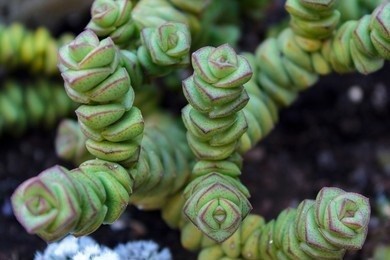Crassula Plant Tissue Culture
 Crassula plant with a unique shape
Crassula plant with a unique shape
Although Crassula plants are small in size, their distinctive
features stand out as a very promising category for development,
and we would like to promote the development
of applications of this genus using
tissue culture technology.
Crassula is the second largest genus in the Crassulaceae family after Sedum, with about 250 to 300 original species, in addition to a large number of hybrids. It is also a genus with a wide variety of morphological variations, with tower-shaped, rosette-shaped, shrubby, and other shapes, fleshy leaves opposite or decussate, and green, white, red, yellow, and mottled leaves.
Compared with the popular and colorful Echeveria succulents, the Crassula succulents of the same Crassulaceae family have a variety of forms and a fresh and chic character. Because of their small size, they are generally used as small or even miniature potted plants, while some plants that have grown for many years are mostly grouped and can be used as medium or large potted plants, which are novel and exotic and have a lot of natural wildernesses.
Smaller species and hybrids native to South Africa are especially popular in the market, and despite the difficulty of cultivation, easy death over summer, and lack of light, many people still rise to the challenge and collect and cultivate them.
Tissue culture service
Unlike traditional propagation methods (cuttings, division, sowing), Lifeasible' tissue culture has significant advantages such as rapidity, high quality, and minimal limitations.
In addition to stem segments as explants, we also use leaves as explants for the induction of healing tissues. Compared to stem segments, leaves produce healing tissue at a slightly slower rate, but the contamination rate of leaves is much lower than that of stem segments. In practice, leaves are used as explants for Crassula plants to multiply in large numbers in tissue culture. So, we establish our customers to provide leaves as tissue material for us to carry out your projects.
In previous projects, the healing tissues of Crassula plants were more easily induced compared to other plants of the Crassulaceae family that had undergone tissue culture, and in the presence of medium contamination, the healing tissues of Crassula continued to grow normally and of higher quality after transfer to clean medium. This indicates that Crassula plants are well suited for tissue culture and are a high-quality and not yet fully exploited material with promising applications.
You want to sign a confidentiality agreement.
You have a specific plant species for your experimental needs.
You have a reliable and relevant cooperation project to discuss.
You are very interested in our project or have any questions.
You need an updated and detailed quotation.
For research or industrial use.

 Crassula plant with a unique shape
Crassula plant with a unique shape
